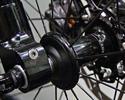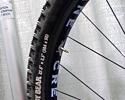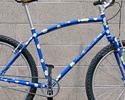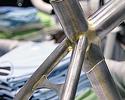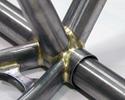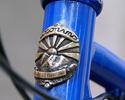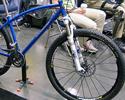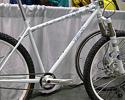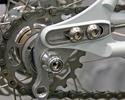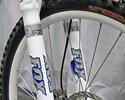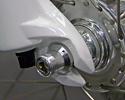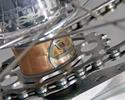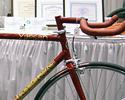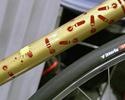
Recently on Cyclingnews.com |
North American Hand Made Bicycle Show -
Portland, Oregon, USA, February 8 - 10, 2008
Main Page Previous Part Next Part
Part 6 - NAHBS still awash with 'normal' bikes
By James Huang in Portland, Oregon
The North American Handmade Bicycle Show has proven to be a consistent showcase for anything and everything attending builders can dream up to build. In many cases, function definitely followed form yet the end result was often a sight to behold nonetheless if only as a rolling example of what could be done. Even so, most (if not all) of the builders on hand also offer perfectly conventional machines and we wrap up this year's coverage with a diverse array of examples.
650B takes hold
Previous shows have been awash with 29"-wheeled mountain bikes whose lesser-used size format was a natural fit for the hand built industry's niche clientele. Fast forward a couple of years, though, and the old 'in between' 650B wheel format resurrected and championed by Kirk Pacenti looks to be well on its way to supplanting 29ers, at least in this crowd.
Pacenti is a long-time frame builder himself but now primarily dedicates the bulk of his time to Pacenti Cycle Design which he intends to be a 'one stop shop' of products and design services that caters to the specific needs of other builders. As a designer, the ramifications of building frames around 29" wheels weren't lost on him and he introduced his 650B concept at last year's show as a viable alternative.
Arguments about yet another wheel size format aside, the idea does seem to hold merit: 650B neatly splits the difference between the two current frontrunners at a rough outside diameter of about 27.5" and at least in theory, offers up a good compromise between the steamrolling ability of 29" rubber and the lighter weight of 26" hoops. More applicably to Pacenti, though, is the fact that 650B wheels are easier to design a frame around, particularly for riders of smaller stature. Full-suspension makers have also caught on to the fact that 650B forces fewer radial geometry modifications in their designs and Ventana showed off at least two samples at the show.
Even so, Pacenti likely could not have predicted how quickly 650B has been adopted especially given the sometimes painfully uphill struggle that 29" proponents suffered in their early days. Multiple builders had examples on display and the supporting players have quickly stepped up to the plate. Velocity already offers two high-performance 650B rims, SUN ringlé and Stan's NoTubes supposedly have models coming out later this spring, Weinmann might be board as well and Cane Creek has toyed with the idea with a handful of prototypes. On the tire side, IRD/Panaracer is already in production, Kenda has committed to three tire models and Schwalbe and CST are strongly considering tossing their hats into the ring, too.
650B bikes were relatively big at NAHBS (pardon the pun) but it's already become clear to us that the idea isn't strictly limited to the cottage industry. We can't say who it is, but we do know of at least one particularly prominent and well-storied full-suspension maker who has a 650B version in the works.
Pavement bikes at NAHBS
On the road side of things, higher-tech materials may have garnered much of the buzz but some of the absolute finest works used a soundly traditional material: steel. Frame building icon Richard Sachs was in attendance again this year and to the casual observer, his familiar paint jobs, lug shapes, and frame configurations might be described as surprisingly stagnant amidst the surrounding and ever-changing sea.
"The most important component is skill set," Sachs insisted. "That's impossible to quantify. I'm constantly improving every aspect. Just the fact that they're painted red doesn't mean anything."
We would be more apt to apply the term 'timeless', particularly as Sachs' classic and recognizable aesthetics envelope thoroughly modern, high-performing and lightweight Columbus steel tube sets and are eminently raceable as evidenced by the masses of Sachs 'cross frames that are flogged weekly by Sachs-sponsored riders and teams. Even at 55 years old (Sachs' birthday coincides with Valentine's Day; Happy Birthday!), Sachs continues to race 'cross himself and continues to look decidedly lean and trim year after year.
Speaking of years, Sachs' waiting list has consistently been measured in multiple complete orbits around the sun instead of phases of the moon. As of the beginning of NAHBS 2008, the quoted lag was six years. At a claimed truly one-man production rate of about 100-120 frames per year... well, you do the math. Do you honestly think that many people are waiting in line for a 'stagnant' bike? We don't think so, either.
Another renowned frame builder made the jump over from Australia for his first-ever appearance at NAHBS. Like Sachs, Darrell McCulloch is a true one-man show behind the Llewellyn line of frames and his overwhelming material of choice is steel given its inherent stiffness, toughness and resistance to fatigue, not to mention its ride quality or the freedom the material presents to him as an artisan. He readily admits that the material is subject to a weight penalty as compared to its non-ferrous counterparts but one look at the reputed equalled-by-some, second-to-none level of quality and craftsmanship is enough to squelch that argument for many.
McCulloch's frames are similarly also designed not just as visual showpieces but functional machines which are infused with his experience as a professional rider racing both in his native Australia and in the European arena as well as his time spent working closely with the Australian Institute of Sport. Even with all of the cutting-edge bicycles currently on the ProTour, several top-level riders are rumoured to have Llewellyn-made bikes in their own personal collection.
Italian frame builder Dario Pegoretti also made the long journey overseas to NAHBS, a feat made only more impressive given that fact that he was diagnosed with lymphoma just last May. Pegoretti is decidedly more progressive in his Columbus steel constructs but his pedigree is arguably no less impressive with top road teams reputedly running his frames in the late 90's (in officially sponsored livery, of course). Unlike Sachs and Llewellyn, though, Pegoretti makes liberal use of TIG welding and dramatically oversized tubing as well as wildly flamboyant paint jobs that leave little uncertainty as to the name on the down tube.
Pegoretti debuted his latest Responsorium Ciaveté as a defiant message to the lymphoma that made him so ill in 2007 (look it up if you're curious, but we'll save you some time and tell you that it's two words, the second of which is 'off'). It bears the same Columbus XCr stainless steel tubing as the standard Responsorium but with the cachet that comes with a frame that is not only guaranteed to have been built by Dario himself but also hand painted as well. Smaller diameter and thinner walled tubing means a lighter and more comfortable ride than some of Pegoretti's stiffer offerings.
And with that, we wrap up our reporting of the North American Handmade Bicycle Show and we hope you've enjoyed it as much as we've enjoyed covering it. Until next year in Indianapolis!
Photography
For a thumbnail gallery of these images, click here
Images by James Huang/Cyclingnews.com
- Kirk Pacenti probably didn't expect the speed at which the 650B wheel size he championed last year would take hold.
- Ventana jumps into the 650B market with a full-suspension model.
- Perhaps Ventana left a 26" bike and a 29" bike in a room together and ended up with this afterwards?
- The modular design of White Brothers' forks easily lend themselves to quick adaptation for 650B.
- Ventana looks to have developed their own way to fit a standard front wheel axle in this 20mm TA fork.
- Cane Creek manufactured a handful of 650B prototypes but don't hold your breath for a production version any time soon.
- Arizona framebuilder Steve Garro has jumped on the 650B bandwagon as well based on this mountain bike that he built for his wife.
- Garro's favored construction method is fillet brazing.
- Fillet brazing yields a cleanly radiused joint.
- Coconino frames are proudly built in Flagstaff, Arizona.
- Coconino also showed off this clean-looking 29er.
- Colorado-based builder Yipsan showed off its own 650B singlespeed model at NAHBS.
- Sliding dropouts ruled at NAHBS and for good reason ; for disc brake-equipped singlespeeds and Rohloff-fitted bikes it's far easier to live with than horizontal dropouts and sliding mounts.
- Yipsan's 650B singlespeed used a Fox 29" fork…
- …who fork tips sported a new shape than most of the Fox forks we've spotted before.
- Yipsan even made up a custom freehub spacer.
- Why use headset spacers when you build the stack right into the stem?
- Yipsan also showed off this fixie…
- …whose celebratory graphics called attention to the Chinese New Year.
- White Brothers has been a key figure in the wheel size wars as the modular design of its forks makes for relatively easy changes.
- White Brothers is advocating its new Q-loQ 20mm thru-axle system which works with existing hubs.
- The Q-loQ standard requires just a simple flip of the QR lever and a twist of the knob to release the axle.
- The non-driveside end of the axle is secured by a bayonet-style attachment.
- Also from White Brothers is its 120mm OLD-wide 20mm thru-axle hub which produces a dishless wheel for better wheel strength.
- Is this a sign of things to come? Even White Brothers is now toying with the idea of using post mount-style brake mounts.
- Engin Cycles returned to NAHBS with a show-special 29er.
- A Reynolds 953 stainless steel front triangle was mated to a Columbus Life rear triangle and a True Temper fork.
- Also on hand was this military-inspired 29er from Engin Cycles.
- Sure, why not use a fork crown for the seat stays, too? Internal routing for hydraulic brake lines was a popular option at this year's NAHBS.
- A custom rack is fitted to the rear end.
- Hand-wrapped shift levers offer a unique look.
- Engin also displayed this good-looking road bike.
- Engin's seatpost head can also be fitted with a carbon mast.
- Just in time for Valentine's Day!
- Engin Cycles will offer its seatpost head in raw form, leaving builders to get as elaborate as they'd like.
- Soulcraft came to NAHBS with a fine 29er…
- …that was equipped with clever pivoting dropouts.
- Shimano's new 29er wheels made several appearances at NAHBS.
- Nick Crumpton is best known for his lightweight road bikes but came to NAHBS with a prototype 29er.
- Will we see this from Crumpton Composites in the near future?
- Wolfhound Cycles made another appearance with its distinctive 29er.
- The split seat tube looks cool but also allows for shorter chain stays.
- Igleheart keeps the 29er torch burning.
- Even with no label you can still tell this bike was made by Christoper Igleheart.
- Hunter Cycles was one of only a few builders to show of a 26"-wheeled mountain bike.
- The unified rear triangle has been done before…
- …but the concentric bottom bracket pivot might give it new legs.
- Bilenky Cycle Works does MTB!
- Yup, more sliding dropouts.
- A cleanly brazed gusset reinforces the front end.
- Nothing terribly fancy going on here but it looks good nonetheless.
- Framebuilding living legend Richard Sachs brought a fleet of bikes all wrapped in his distinctive and easily recognizable paint scheme.
- Sachs is deeply involved with his local 'cross racing scene in terms of sponsorship but also races himself.
- Classic lines adorn Sachs' machines.
- Even for 'cross , Sachs prefers steel forks.
- This older Sachs frame may bear a lot of visual resemblance to newer models but the underlying materials have been thoroughly updated.
- Darrell McCulloch made the journey from Australia to show off his Llewellyn frames.
- Sure, carbon is newer but wow, it sure doesn't look like this.
- With workmanship like this it's easy to see why McCulloch's frames are widely regarded as some of the finest steel frames currently available.
- It's easy to fall in love with McCulloch's Llewellyn frames!
- There's nothing cookie-cutter about these.
- McCulloch equipped one of his Llewellyn frames with yet another variant of Engin Cycles' seatpost head.
- Llewellyn also does track frames and McCulloch has lots of experience working with the Australian national team.
- It's a subtle detail but one that many can't be bothered to do.
- Yum!
- A number of Llewellyn lugs await their new home.
- Brett Horton of The Horton Collection and Darrell McCulloch catch up on lost time at NAHBS.
- Llewellyn also produces its own wind trainers that are used by the many riders trackside.
- Dario Pegoretti is apparently doing well after being diagnosed with cancer last year and has been busy building frames.
- Pegoretti's stainless steel Responsorium model made another appearance this year.
- Beefy dropouts keep the back end in check but sizeable cutouts still keep the weight down.
- Pegoretti also does lugged frames.
- Pegoretti is a big fan of extended head tubes in certain size ranges.
- Why put the model name on the top tube when you can integrate it right into the lug?
- Well wishes from Dario!
- The Luigino is a rather versatile Pegoretti model.
- The lugged Luigino model can also be fitted with horizontal dropouts.
- Show organizer Don Walker is an accomplished framebuilder in his own right.
- Walker specializes in track bikes.
- Walker's oldest daughter apparently expressed to her dad that she wanted to be a track racer.
- Naturally, Walker wasted little time in building her a bike of her own!
- Classic chromed track bars are fitted to the front end.
- Walker also does road bikes but this one still only has one gear!
- Walker does ornate-looking lugs, too.
- The new 'face' of Don Walker Cycles.
- Walker's track tandem makes another appearance at this year's NAHBS.
- Now this is just wrong.
- Walker shows off a gift from Brett Horton.
- Mark Nobilette has been in the business a long time…
- …and his work shows it.
- Check out the detail on this one!
- Nobilette is adept at a wide variety of construction methods but his lugged bikes are arguably his prettiest.
- Brian Baylis is a fixture in the framebuilding scene…
- …as both a builder and a painter.
- Oregon-based builder John Slawta displayed this Land Shark fixie…
- …which was fitted with decidedly unconventional seat stays!
- Slawta offers a wide variety of bicycle types…
- …and is well known for elaborate paint jobs.
- Curtis Inglis' Retrotec bikes are always striking and this one was no exception.
- S&S couplings on the twin top tube and down tube, though, make this one especially handy, though.
- The drilled out eccentric shaves some weight.
- Sure, why not?
- Inglis carries the Retrotec design theme to another level with this one.
- How many top tubes do you need?
- The keyhole dropout can be split open for use with a Carbon Drive Systems belt drive.
- Just slightly nicer than my personal townie bike…
- This thing is as much art as machine.
- Ok, so it's not a 'normal' road or mountain bike , but we still didn't want to pass it over, either.
- This Grognard fixie was one of the more heavily stylized examples on the showroom floor.
- These bars might not be the most practical shape but they sure do look cool.
- Care to build a try your hand at a set of these, Zack?
- This Waterford looked almost specifically built for the needs of the local Portland crowd.
- Stainless lugs include a bit of an extension for a slightly more upright riding position.
- Wood fenders look like they won't offer much protection but apparently work quite well.
- J.P. Weigle is perhaps best known for his Frame Saver but he's an accomplished builder as well.
- California-based Rebolledo Cycles showed off this beautiful randonneur bike.
- Sheila Moon continues to cater specifically to the women's crowd.
- Sheila Moon expands on its line of Dri-Release Wool Fleece clothing with this women's hoodie.
- The new hoodie is high on style but also on function with two rear pockets and one additional pocket on the sleeve.
- Riding knickers have seemingly grown in popularity.
- Sheila Moon's Dri-Release material is also found in a new vest.
- A single rear pocket is found back here.
- Selle Italia showed off a handful of new styles that will debut in the coming months.
- A new Selle Italia Lady Gel Flow saddle will join the lineup in the near future.
- Another look at the new Hayes Stroker Gram. The master cylinder is aggressively machined for maximum weight savings.
- The caliper features alloy-backed pads and titanium bridge bolts.
- fi'zi:k showed off its design talent again with a wall full of Andy Warhol-like posters.
- Ritchey debuted a new line of lighter unidirectionally finished carbon fiber handlebars.
- Sutherland's offered wheelbuilders a new means of accurately measuring actual effective rim diameter (ERD).
- The new Sutherland's system is easier to use than the old rim rods and claimed to be more accurate, too.
- The SRAM robots made yet another trip…
- …but all of that travel is taking its toll. This arm is supposed to be attached to the body!





